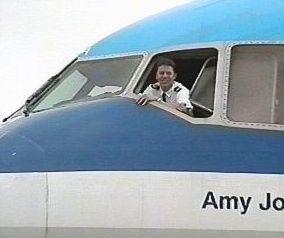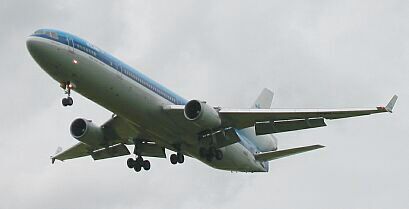About the author of the FDC toolbox
This site, the toolbox, and the accompanying documentation were written and designed by Marc Rauw. Here you can find the personal resumé of the author, just in case you're interested. This doesn't mean that I'm looking for another job right now, because I'm very happy at KLM, but if you really have an offer I can't refuse, just press the feedback button and send me a high-priority e-mail. :-)
 M.O. Rauw
M.O. RauwSchuilenburg 14
2036 BL Haarlem
The Netherlands
Education
August 1982 - July 1988:
Montessori Lyceum 'Herman Jordan', Zeist, The Netherlands.
August 1988 - September 1993:
Faculty of Aerospace Engineering, Delft University of Technology, Delft, The Netherlands. Obtained Master's degree in Aeronautical Engineering in September 1993.
Major subjects:
Mathematics, mechanics, low and high-speed aerodynamics, structural design, materials, aircraft performance, signals and systems, control theory, aircraft stability and control, flight-simulation, aircraft instruments, flight dynamics in atmospheric turbulence, system modeling and identification.
Related subjects:
Engineering economics, technical writing.
Graduation Project:
Design and evaluation of a 'classical' autopilot for the De Havilland DHC-2 'Beaver' aircraft, the former laboratory aircraft of the Section Stability and Control (nowadays called the Control & Simulation Division). I built the Matlab / Simulink models for nonlinear flight simulation, performed nonlinear simulations, and co-operated with other students and staff members of the Faculty to test the autopilot in real flight. The simulation software was later transformed to the Flight Dynamics and Control toolbox.
Work Experience
November 1991 - February 1992:
Traineeship at the Dutch National Aerospace Laboratory (NLR), where I worked on aerodynamic modeling of the Swearingen Metro II laboratory aircraft.
January 1994 - January 1995:
Military service as reserve officer for the Naval Air Arm of the Royal Netherlands Navy (dutch link). I was responsible for maintaining and improving software for the 6-DOF flightsimulator of the Lockheed P3C Orion maritime patrol aircraft, and designed Omega radio-navigation simulation software for use in the tactical trainer of the Orion aircraft (a high-performance real-time simulator used for the training of complete Orion crews).
October 1997 - present:
Working as an airline pilot for KLM Royal Dutch Airlines (see below).
November 1993 - present:
Development of flight simulation software for Matlab / Simulink plus documentation for Delft University of Technology and others (this work has resulted in the Flight Dynamics and Control Toolbox as it is available today).
Flight Experience
February 1995 - January 1997:
Ab-initio flight-training at the KLM Flight Academy (KLS).
October 1997 - October 2002:
Second Officer on the McDonnell-Douglas MD-11 for KLM Royal Dutch Airlines.
November 2002 - present:
First Officer Boeing 737 for KLM, ATPL.

McDonnell-Douglas MD-11, KLM Royal Dutch Airlines.
Logged flight hours:
Note: this list is usually lagging behind a couple of months. It currently reflects the situation at the end of April 2005.
Boeing 737-300, -400, -800, and -900:
1285 actual flight hours as First Officer for KLM; 105 hours Boeing 737 flightsimulator.
McDonnell-Douglas MD-11:
3515 flight hours as Second Officer (cruise relief co-pilot) for KLM; 178.5 hours MD-11 flightsimulator.
Airbus A310:
KLM 'Bridge-Course' at the KLM Flight Academy (equivalent to approximately 80% of the A310 type-qualification, with emphasis on crew-coordination and emergency procedures), consisting of 81 hours A310 flightsimulator.
Beechcraft BE-58 'Baron':
Advanced IFR flight training at the KLM Flight Academyfor twin-engined aircraft. 25 hours, of which 19 hours as Pilot in Command.
Beechcraft BE-36 'Bonanza':
Basic IFR flight training at the KLM Flight Academy. 80 simulator hours, half of which as Pilot Flying. 45 hours actual flight, of which 39 as Pilot in Command.
Slingsby 'Firefly':
Basic VFR training at the KLM Flight Acacemy. 79 hours, of which as 47 hours Pilot in Command.
Cessna 172:
5 hours C172 flightsimulator and 20 hours actual flight.
Computer Experience
Programming and Internet:
Matlab/Simulink, HTML, XHTML, CSS, Fortran, Pascal, C, C++.
Operating systems:
MS DOS, Windows 9x, Windows 2000, VAX/VMS.
Miscellaneous:
LATEX, Adobe Acrobat.
Publications
- Rauw, M.O.: "FDC 1.2 - A Simulink Toolbox for Flight Dynamics and Control Analysis". Zeist, The Netherlands, 1997 (second edition: Haarlem, The Netherlands, 2001). This is a technical report about mathematical modelling and simulation techniques, which also includes a detailed FDC toolbox user-guide.
- Rauw, M.O.: "Omega Simulation Software for the OTT (Operational Tactical Trainer)". Internal report for the Royal Netherlands Navy. Katwijk (ZH), The Netherlands, January 1995.
- Rauw, M.O., Bennani, S., Van der Vaart, J.C.: "An Integrated Approach to the Design of Flight Control Systems using CAD Tools". Paper presented at the third ESIEE congress "2AO Automatique Assistée par Ordinateur" ('computer-assisted automation'), Noisy-le-Grand Cedex, France, November 17-18, 1994.
- Rauw, M.O.: "A Simulink Environment for Flight Dynamics and Control analysis - Application to the DHC-2 'Beaver' " (2 parts). MSc-thesis, Delft University of Technology, Faculty of Aerospace Engineering. Delft, The Netherlands, 1993. Available through the Scientific and Technical Information database of NASA; report number NONP-NASA-SUPPL-DK-94-28027, or via the Other Downloads page on this website.

